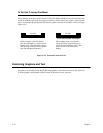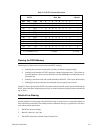
5–7Vertical Format Units
DVFU
The DVFU may be selected in P–Series protocol and is generally used in conjunction with the
Dataproducts
interface. A maximum of 12 channels can be assigned to each physical line of a form—
up
to 143 lines. A channel number is assigned to each line on the form. The host computer sends
chan
-
nel codes to the printer, resulting in rapid paper slewing to the next corresponding line. The
programming
sequence follows this order: 1) start load code,
2) channel assignments,
and
3) end load
code.
The DVFU start load codes are either 6C, 6D, or 6E hex with the PI line high.
Start Load Code – 6C, 6D, or 6E Hex
6E
Hex
– The DVFU start load code of 6E (hex) with the PI line high initiates the DVFU memory load
routine using the current printer line spacing as the DVFU line spacing.
6C
Hex
– The DVFU start load code of 6C (hex) with the PI line high initiates the DVFU memory load
routine using 6 lpi as the line spacing, regardless of the current printer line spacing.
6D
Hex
– The DVFU start load code of 6D (hex) with
the PI line high initiates the DVFU memory load
routine using 8 lpi as the line spacing, regardless of the current printer line spacing.
Channel Assignment
Following
the start load code, all data bytes received are interpreted as channel assignment data
until
the
end load code is received.
During the channel assignment portion of the load routine, the PI line can
be high or low; if high, however
, the channel data
cannot
be the same as start
or
end load code data. The
last
channel 12
loaded is assigned Bottom–of–Form (BOF). If skip–over perforation is enabled, slew
-
ing will occur from the bottom of the form to the top of the form.
A
maximum of 12 channels can be assigned to one physical line on the form (multiple channels per line
facilitate
the use of a single DVFU load for multiple forms). T
wo eight–bit data bytes (DVFU charac
-
ters)
are required per line. As shown in T
able 5–4, the least significant six bits of the first data byte are
used to assign channels 1 through 6; the least significant six bits of the second data byte are used to
assign channels 7 through 12. If a bit is set, the corresponding channel is assigned.
Each
line on the form requires two
bytes. For lines not requiring a channel identification, the two bytes
should
not contain channel assignments.
A
maximum
of 143 lines (286 DVFU bytes) can be assigned on the form. If the printer receives more
than
286 bytes without an end load code, the end load code is “forced” and the load routine is termi
-
nated.
CH 1 TOF – The first channel, line 1 of the form, must be assigned channel 1, top–of–form, or the
entire load sequence is ignored and the memory reset. Consequently, when preparing to load the
DVFU
memory
, position the paper at the required top–of–form position in anticipation of sending the
TOF
channel assignment code as the first line loaded. After the memory is loaded, a Form Feed code
(FF, 0C hex) moves the paper to the next channel 1 (top–of–form).
CH
2 VT
– Channel 2 is designated as the vertical tab channel. After the memory is loaded,
a VT code
(0B
hex) moves the paper to the next channel 2. If the printer receives a VT code but channel 2 is not
loaded,
the paper advances a single line at the current line spacing.


















